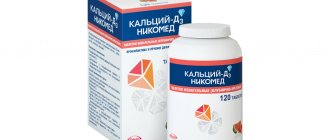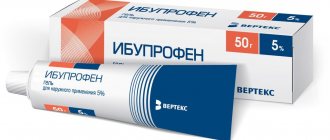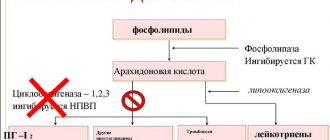Composition and release form
| Capsules | 1 caps. |
| chondroitin sulfate sodium | 0.25 g |
| excipients: lactose (milk sugar); calcium stearate | |
| gelatin capsule composition: titanium dioxide; Azorubine dye; crimson dye (Ponceau 4R); patented blue dye (patent blue V); diamond black dye (diamond black BN); methyl parahydroxybenzoate (methylhydroxybenzoate); propyl parahydroxybenzoate (propylhydroxybenzoate); acetic acid; gelatin |
in a blister pack 10 pcs.; in a cardboard pack of 5 packs or in jars of 20 pcs.; in a cardboard pack 1 jar.
| Ointment 5% | 100 g |
| chondroitin sulfate sodium (calculated on dry matter) | 5 g |
| dimexide (dimethyl sulfoxide) | 10 g |
| excipients (base): anhydrous lanolin; medical Vaseline; purified water |
in aluminum tubes of 30 g; in a cardboard pack 1 tube.
Overdose
The drug must be taken in strict accordance with the dosage prescribed in the medical institution. If you increase the prescribed dose yourself, this may cause an overdose. At the same time, a strong decrease in blood pressure is often accompanied by pulmonary embolism, myocardial infarction, and impaired blood flow in the brain.
Taking too much of the drug may cause an overdose
The condition requires immediate medical attention using symptomatic therapy and hemodialysis. Lack of timely assistance leads to the development of severe complications and death of the patient.
Pharmacodynamics
Capsules. Affects metabolic processes in hyaline and fibrous cartilage, reduces degenerative changes in the cartilage tissue of joints, stimulates the biosynthesis of glycosaminoglycans. Slows down bone resorption and reduces calcium loss, accelerates bone tissue restoration processes. When treated with Chondroitin-AKOS, pain decreases and mobility of the affected joints improves. The therapeutic effect persists for a long time after the end of the course of treatment.
Ointment. Chondroitin-AKOS contains chondroitin sulfate, a stimulator for the restoration of cartilage tissue in joints (chondroprotector), obtained from bovine tracheal cartilage, and dimethyl sulfoxide.
Chondroitin sulfate is a high-molecular mucopolysaccharide that inhibits the processes of destruction of cartilage tissue and accelerates the processes of its restoration. Suppresses enzymes that cause damage to cartilage tissue and prevents its degradation; stimulates the biosynthesis of glycosaminoglycans by chondrocytes; promotes the restoration of the joint capsule and cartilaginous surfaces of the joints, increases the production of intra-articular fluid. Improves phosphorus-calcium metabolism and reduces calcium loss in cartilage tissue, slows down bone resorption, normalizes metabolism in hyaline tissue, accelerates regeneration (recovery) processes and inhibits degeneration (destruction) of cartilage tissue. Structurally close to heparin, it prevents the formation of fibrin blood clots in the synovial and subchondral microvasculature. As a result of the effect, pain decreases and mobility of the affected joints increases.
Dimethyl sulfoxide, which is part of the ointment, has an anti-inflammatory, analgesic and fibrinolytic effect, promotes better penetration of chondroitin sulfate through cell membranes deep into tissues.
Chondroitin-AKOS ointment has an analgesic and anti-inflammatory effect, normalizes metabolism and stimulates restoration processes in joint tissues, leads to a reduction or disappearance of pain in the joints, improves joint mobility, and slows down the progression of osteoarthrosis and osteochondrosis.
Ibuprofen-akos suspension 100mg/5ml orange 100 ml
With simultaneous use, ibuprofen reduces the effect of antihypertensive drugs (ACE inhibitors, beta-blockers), diuretics (furosemide, hydrochlorothiazide).
When used simultaneously with anticoagulants, their effect may be enhanced.
When used simultaneously with GCS, the risk of side effects from the gastrointestinal tract increases.
When used simultaneously, ibuprofen can displace indirect anticoagulants (acenocoumarol), hydantoin derivatives (phenytoin), and oral hypoglycemic drugs, sulfonylurea derivatives, from compounds with blood plasma proteins.
When used simultaneously with amlodipine, a slight decrease in the antihypertensive effect of amlodipine with acetylsalicylic acid is possible - the concentration of ibuprofen in the blood plasma with baclofen decreases - a case of increased toxic effect of baclofen is described.
When used simultaneously with warfarin, an increase in bleeding time is possible; microhematuria and hematomas with captopril were also observed - a possible decrease in the antihypertensive effect of captopril with cholestyramine - a moderately pronounced decrease in the absorption of ibuprofen.
When used simultaneously with lithium carbonate, the concentration of lithium in the blood plasma increases.
When used simultaneously with magnesium hydroxide, the initial absorption of ibuprofen with methotrexate increases - the toxicity of methotrexate increases.
The simultaneous use of NSAIDs and cardiac glycosides can lead to worsening heart failure, a decrease in glomerular filtration rate and an increase in the concentration of cardiac glycosides in the blood plasma.
There is evidence of the likelihood of an increase in the concentration of methotrexate in the blood plasma during the use of NSAIDs.
With simultaneous use of NSAIDs and cyclosporine, the risk of nephrotoxicity increases.
NSAIDs may reduce the effectiveness of mifepristone, so taking NSAIDs should be started no earlier than 8-12 days after stopping mifepristone.
Concomitant use of NSAIDs and tacrolimus may increase the risk of nephrotoxicity.
Concomitant use of NSAIDs and zidovudine may lead to increased hematotoxicity.
There is evidence of an increased risk of hemarthrosis and hematomas in HIV-positive patients with hemophilia who received concomitant treatment with zidovudine and ibuprofen.
In patients receiving concomitant treatment with NSAIDs and quinolone antibiotics, the risk of seizures may increase.
In patients receiving concomitant NSAIDs and myelotoxic drugs, hematotoxicity increases.
With the simultaneous use of ibuprofen and cefamandole, cefoperazone, cefotetan, valproic acid, plicamycin, the incidence of hypoprothrombinemia increases.
With the simultaneous use of ibuprofen and drugs that block tubular secretion, there is a decrease in excretion and an increase in plasma concentration of ibuprofen.
With the simultaneous use of ibuprofen and inducers of microsomal oxidation (phenytoin, ethanol, barbiturates, rifampicin, phenylbutazone, tricyclic antidepressants), there is an increase in the production of hydroxylated active metabolites and an increased risk of developing severe intoxications.
Contraindications
For both dosage forms: hypersensitivity to the components of the drug.
For capsules additionally: children under 15 years of age (due to lack of accurate data).
With caution: bleeding and tendency to bleeding, thrombophlebitis.
For ointment additionally: acute inflammatory processes in the wound area; widespread tissue necrosis; excessive granulation; violation of the integrity of the skin at the sites of intended application.
With caution: do not use Chondroitin-AKOS ointment without consulting a doctor during pregnancy and breastfeeding, as well as in childhood.
Similar drugs:
- Furacilin Solution for topical use
- Lactobacterin siccum dry (Lactobacterin siccum) Lyophilisate for the preparation of solution for oral administration
- Palin Capsule
- Bactrim Oral suspension
- Nitroxoline Oral tablets
- Pancef Oral tablets
- Nifuroxazide (Nifuroxazide) Oral tablets
- Ercefuryl Oral suspension
- Sextaphag Oral solution
- Pancef Granules for the preparation of suspension for oral administration
** The Drug Directory is intended for informational purposes only. For more complete information, please refer to the manufacturer's instructions. Do not self-medicate; Before starting to use the drug Ceftriaxone-AKOS, you should consult a doctor. EUROLAB is not responsible for the consequences caused by the use of information posted on the portal. Any information on the site does not replace medical advice and cannot serve as a guarantee of the positive effect of the drug.
Are you interested in the drug Ceftriaxone-AKOS? Do you want to know more detailed information or do you need a doctor's examination? Or do you need an inspection? You can make an appointment with a doctor - the Euro lab is always at your service! The best doctors will examine you, advise you, provide the necessary assistance and make a diagnosis. You can also call a doctor at home . Euro lab clinic is open for you around the clock.
** Attention! The information presented in this medication guide is intended for medical professionals and should not be used as a basis for self-medication. The description of the drug Ceftriaxone-AKOS is provided for informational purposes only and is not intended for prescribing treatment without the participation of a doctor. Patients need to consult a specialist!
If you are interested in any other drugs and medications, their descriptions and instructions for use, information about the composition and form of release, indications for use and side effects, methods of use, prices and reviews of drugs, or you have any other questions and suggestions - write to us, we will definitely try to help you.
Directions for use and doses
Orally, during or after meals, with at least 1/2 glass of water.
Adults and adolescents over 15 years of age are prescribed 1 g/day (2 capsules 2 times a day).
The recommended duration of the initial course of treatment is 6 months, the period of action of the drug after its discontinuation is 3–5 months, depending on the location and stage of the disease, the duration of repeated courses of treatment is determined by the doctor.
Externally. Chondroitin-AKOS ointment is applied 2-3 times a day to the skin over the lesion and rubbed in for 2-3 minutes until completely absorbed. Typically, the course of treatment ranges from 2–3 weeks to 2 months. If necessary, the course of treatment is repeated.
Possible side effects
The abstract for Captopril indicates the possibility of developing the following negative consequences:
- numbness, tingling in the limbs;
- frequent headaches turning into migraines;
- fog, dizziness;
- chronic fatigue, muscle weakness;
- increased heart rate;
- disruption of the functioning of the digestive system (diarrhea or constipation, nausea, belching, heartburn, change in taste, loss of appetite, increased concentration of bilirubin, hepatitis, cholecystitis);
- changes in blood composition of a qualitative and quantitative nature;
- dysfunction of the urinary system.
Severe side effects include bronchospasms, Quincke's edema, swollen lymph nodes, and serum sickness.
Incorrect use of the medicine leads to side effects
Important! If such reactions occur, you should stop therapy and seek medical help.
special instructions
If you miss taking a medication, the dose does not need to be increased; the next dose of medication is taken according to the prescribed regimen.
Despite the fact that the drug has positive reviews, it is highly not recommended to use it on your own.
It is prohibited to combine the product with alcoholic beverages.
During treatment, blood pressure should be measured regularly.
Patients undergoing therapy with the drug should undergo regular medical examinations and tests to monitor the vital systems of the body.
Patient reviews
Stepan, Samara “My sister is not yet 30, but she already suffers from periodic increases in blood pressure. She has a severe headache, tinnitus, and fatigue. I advised her on Captopril Akos, since I myself have been using this medicine for a long time, and it helps me well. The drug also worked for my sister, now the pills are always in her medicine cabinet, they have become a real first aid.”
Irina, Tomsk “Several years ago I was diagnosed with stage 2 hypertension, since then I have always had antihypertensive drugs at hand. I don’t use Captopril Akos every day; the doctor prescribed a milder medicine, but in case of a sharp and severe increase in blood pressure, this drug is simply necessary. I put the tablet under my tongue and after 20-30 minutes the condition improves. I think this remedy is an excellent way to prevent complications.”
Maxim, Kirov “Captopril Akos is really good at lowering blood pressure, but you need to know that you should not take more than 3 tablets per day, this can cause very serious consequences. One day my blood pressure increased significantly and I had to call an ambulance. It was Captopril Akos that knocked him down, and since then I always have this remedy with me.”
Stanislav, Moscow “I rarely use medications on my own, but recently I had to do it. While relaxing in nature, I suddenly felt sick, dizzy, had tinnitus, and increased blood pressure. My friends had Captopril tablets with them. Fortunately, they suited me well and my blood pressure dropped quickly, without any negative consequences for me. After that, I discussed the case with my doctor, and he advised me to keep the funds with me at all times.”



